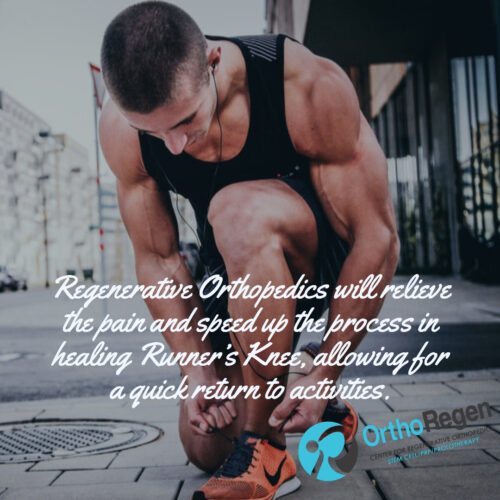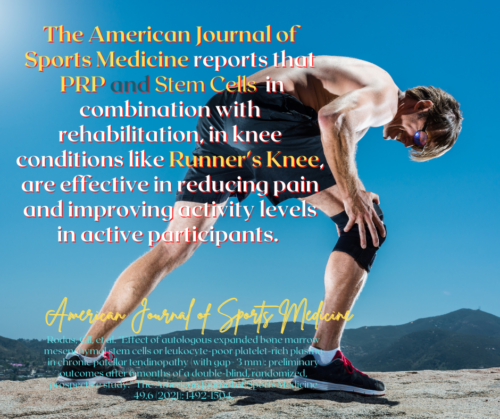
Runners Knee
Runner’s Knee is a painful knee condition that is, like the name says, common in runners. Another name for Runner’s Knee is Patellofemoral Pain Syndrome (PFPS). And it is characterized by anterior knee pain.
Sufferers of this condition commonly experience pain behind and around the kneecap or patella. Runner’s Knee can affect one or both knees and is a knee complaint among athletes and non-athletes alike. It particularly affects adolescents and young adults. And it is quite common in younger recreational runners, with females suffering more frequently than males.
Several forces act on the patella to provide stability and keep it tracking properly, as it articulates with the patellofemoral groove in the femur.
The patella not only moves up and down but also tilts and rotates. That allows for various points of contact between the patella and femur. Repetitive contact at these locations combined with the abnormal articulation of the patella is thought to be the cause of the pain behind and around the patella in patellofemoral pain syndrome.
Patellofemoral Pain Syndrome should be distinguished from chondromalacia. Chondromalacia is actual fraying and damage to the underlying patellar cartilage. Chondromalacia patella can be a cause of patellofemoral pain syndrome.
There are many theories to explain the pathophysiology of Runner’s Knee. They include muscular, overuse, and biomechanical theories. The cause of pain and dysfunction may result from abnormal forces such as tight or weak quadriceps, subluxation, or dislocation of the patellofemoral joint can also present.
Runner’s Knee may be due to prolonged repetitive activities such as running or jumping, which put excessive sheering forces on the patellofemoral joint. And anatomic factors that predispose toward patellofemoral pain or instability include excessive rotation of the hip or shin bone, knock knees, hyperextended knees, and/or poor foot alignment. Also, ligamentous, meniscal, and soft tissue damage can cause patellofemoral pain syndrome. Other causes of patellofemoral pain are fractures, arthritis of the knee, and bony tumors in or around the knee.
Although the exact etiology of Runner’s Knee is unclear, the abnormal articulation along with abnormal muscular and other biomechanical factors change the forces placed upon the patellofemoral joint. The abnormal movement leads to instability and improper tracking as the patella articulates with the patellofemoral groove in the femur.
For example, when the knee is flexed, the patella glides through the groove in the femur. If the bones in the lower leg are not aligned correctly, this gliding becomes abnormal. An overload on the patellofemoral joint occurs with flexion of the knee (bending) as this movement increases the pressure between the patella and the various contact points with the femur. With repeated episodes, the joint becomes unstable. Especially if the joint remains out of alignment. This abnormal tracking can lead to increased wear between the bone surfaces, and eventually the articular cartilage.
Besides the tenderness behind, around, and at the center of the patella, there may also be pain toward the back of the knee. Crepitation or cracking sounds may be heard, as well as a feeling of instability in the knee joint. The pain typically occurs with activity. And it often worsens with activities that include steps, hills, and uneven surfaces.
Going downhill or downstairs aggravates the condition. Prolonged sitting can trigger pain due to the extra pressure between the patella and femur during knee flexion. Straightening of the legs may decrease the discomfort. Squatting and kneeling also exacerbate the pain, which can be dull, sharp, or burning.
The common treatment approach for Runner’s Knee usually involves activity modification, anti-inflammatory medications, the RICE protocol, ultrasound, and orthotics. And physical therapy is often recommended. PT may include quadriceps-based exercises together with hamstrings, quadriceps, gastrocnemius, anterior hip muscles, and iliotibial band stretching exercises.

PRP and Stem Cells Are Effective for Runner’s Knee
This approach may help temporarily. But it does not fix the problem of instability in the knee joint which is causing the misalignment. With Runner’s Knee, instead of tracking in the groove of the femur, the patella oftentimes tracks laterally. A sunrise view X-Ray and a functional assessment of the knee by the physician will reveal how the patella is tracking. Strengthening of the vastus medialis may be helpful. And exercises such as cycling are recommended, but often that alone will not resolve the Runner’s Knee.
Regenerative Orthopedics, including PRP and/or Prolotherapy injections to the medial side of the patella, will strengthen the attachment of the vastus medialis to the patella. The resultant strengthening pulls the patella into the groove, which allows for a realignment of the patella.
Regenerative Orthopedics along with vastus medialis strengthening will relieve the pain and speed up the process of normalizing the patellar tracking in Runner’s Knee. The combination allows for a quick return to activities.
A 2021 article in “The American Journal of Sports Medicine” says PRP, in combination with rehabilitation, is effective in reducing pain and improving activity levels for those with knee injuries like Runner’s Knee.1
Rodas, Gil, et al. “Effect of autologous expanded bone marrow mesenchymal stem cells or leukocyte-poor platelet-rich plasma in chronic patellar tendinopathy (with gap> 3 mm): preliminary outcomes after 6 months of a double-blind, randomized, prospective study.” The American Journal of Sports Medicine 49.6 (2021): 1492-1504.